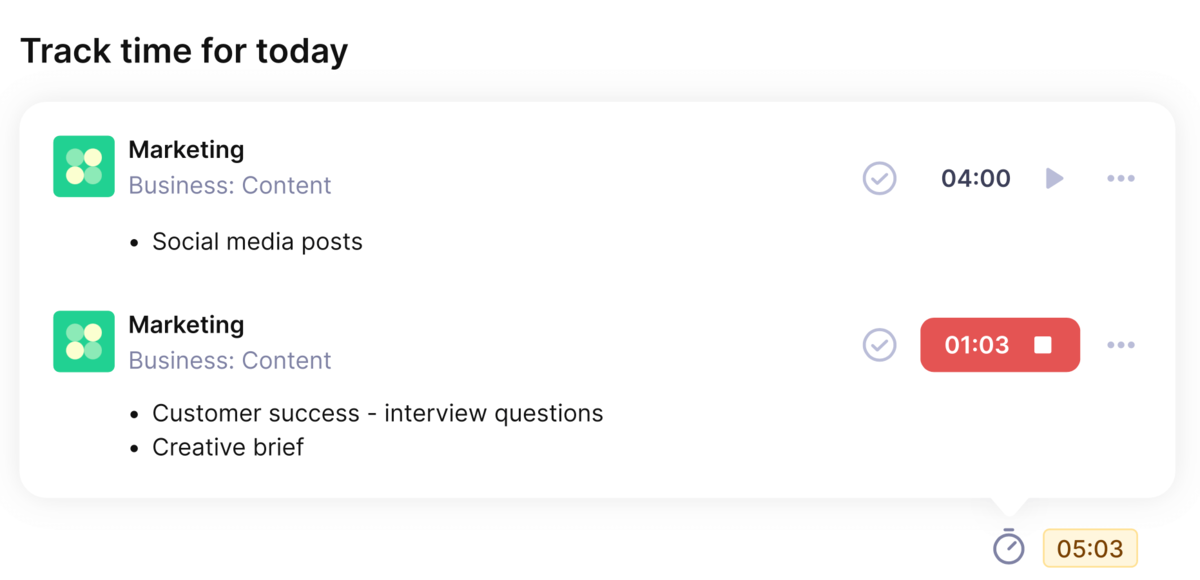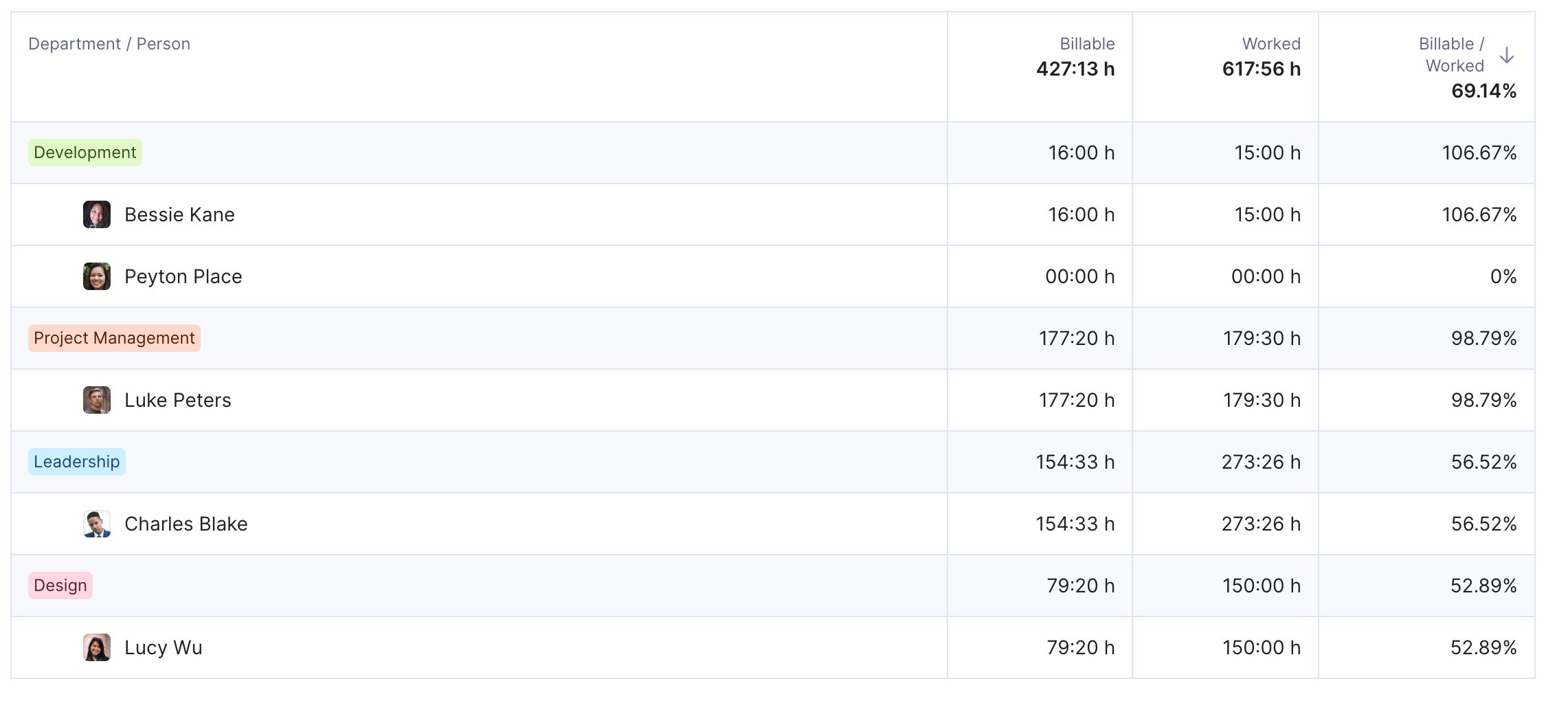Billability: What Is It and How to Measure It
Billability is a key metric that provides clarity on your team’s productivity, project performance, and finances. It depicts the amount of time that your employees are spending on tasks related to client projects, or in short, the ratio of billable time tracked vs total hours worked. In this article, we’ll provide answers to four main questions:
- What is billability, and how do you calculate it?
- What is the difference between billability and utilization?
- Why is it so important?
- And how do you optimize it?
What Is Billability?
Billability is a metric used in professional services to gauge productivity and efficiency. It’s the percentage of time your employees spend on client-facing tasks vs their total hours tracked.
Billable hours include a wide range of activities spent on billable projects, such as client meetings and time directly spent working on deliverables. Non-billable hours include administrative tasks non-related to projects, internal meetings, skill-building initiatives, pitching for new clients, etc.
Billability vs Utilization: Is There a Difference?
During your career or while browsing resources, you’ve probably come across the term billable utilization, utilization, or utilization rate. So, what’s the difference between billability and billable utilization rates?
The way these two terms are understood can vary from business to business. They’re either used synonymously or seen as connected but different terms.
Under the second interpretation, we would define the two in the following way:
- Billability is seen as the scheduled or planned billable rate for a certain period; for example, an employee’s billability can be set to be 70% for Q1
- Billable utilization is seen as the number of billable hours vs actual hours worked; for example, the same employee has a workshop set in Q1, which brings their billable utilization down to 65%
In this article, we’ll use both terms synonymously, but it can be useful to know this distinction.
How to Calculate Billability
To calculate your utilization, you’ll need to implement regular time tracking. You’ll also need to set a system for differentiating billable work from non-billable activities; while project managers can do this manually in a spreadsheet or similar tools, professional services time tracking software solutions help automate this process.
Which activities count under billable or non-billable time can vary depending from project to project. For example, a development company might need to invest in learning technology fundamentals as non-billable time, but researching a niche or specific solution to resolve a project task can count as part of a billable project. All of this depends on the agreement you have with your client.

Productive’s time tracking automates the tracking of billable and non-billable work
Billability can be tracked per employee or per department, but it can also be examined according to seniority or specific skills. These insights can help you get a comprehensive understanding of your workforce planning activities and aspects you need to improve upon.
You can track your employee utilization rate on a weekly, monthly, quarterly, or annual basis to get both granular and long-term insights.
Manage Your Billability With Productive
Switch from multiple tools and spreadsheets to an all-in-one solution for your resourcing and project financial management.
The Importance of Managing Utilization
Here are the four main reasons why you need to track utilization for successful business operations:
1. Revenue Tracking
It helps you keep track of how much time you’re putting into revenue-generating activities. Since this is the main driver of your company’s profitability, balancing hours spent on client work and administrative tasks is crucial to your financial health and sustainable operations.
Check out our guide to revenue operations strategy to learn more.
2. Optimizing Efficiency
It’s also a useful capacity management KPI for your team’s productivity and efficiency. If more time than expected is being put into non-project-related tasks, this can signal workflow breakdowns, such as miscommunication or resource conflicts. You can more easily pinpoint specific issues to improve project performance and overall client satisfaction.
3. Strategic Decision-Making
Understanding your utilization rates (and being able to forecast them for future periods) can guide your strategic planning. For example, if you know that your design team will be overutilized for a specific period, you can consider taking on external staff to meet resource demand. Or, you can target underutilized services and guide your sales team toward prospecting for them.
That’s a key thing that we get out of the reports that really feeds into our utilization and resourcing. If we know we’re doing 30% on internal projects, then we know we’ve got the capacity to take on more client work.
Learn how Productive helps business leaders get real-time insights into agency performance.
4. HR Management
Finally, but no less importantly, managing your utilization rates isn’t only relevant to your finances. It also helps you monitor your human resource planning process, so that you can ensure that no employee is overutilized or underutilized. This is important for ensuring a satisfied workforce, decreasing the risk of burnout, and reducing attrition and turnover.
Tips for Optimizing Billable Hours
The industry standard for billability ranges from 70% to 90%, though this can vary significantly depending on your industry, business specifics, and employee roles.
If you’re looking to boost your company’s billable rates, here are some things you can focus on:
- Set billable hours targets, make sure they are realistic and achievable, and communicate these expectations clearly to employees
- Look into reducing non-billable hours by streamlining processes, such as automating repetitive parts of your workflows (for ex., collecting data for reporting and invoicing)
- Make sure you’re monitoring progress so you can compare different projects and workflows and figure out which one works the best for your agency
- Consider implementing resource management software to help you track your data, employee availability, and other key considerations; according to The Wow Company, this can boost your billability by almost 10%
Manage Your Billable Time With Productive
Looking for software to help you manage billable and non-billable hours, track your profit margin, and visualize and forecast resource utilization rates?

Productive delivers and forecasts your billable utilization calculation in real time
Consider Productive, the all-in-one management software designed specifically for service businesses and their workflows. With Productive, you can:
- Handle employee availability, time off, and allocation
- Manage billable hours and get real-time billable utilization metrics
- Build your project budgets and streamline invoicing
- Track project estimates and tasks, automate workflows, and much more
Book a demo with Productive today to learn how you can optimize your team utilization rates.
Connect With Agency Peers
Access agency-related Slack channels, exchange business insights, and join in on members-only live sessions.

